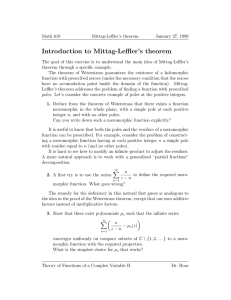Slowly growing meromorphic functions and the zeros of differences
advertisement
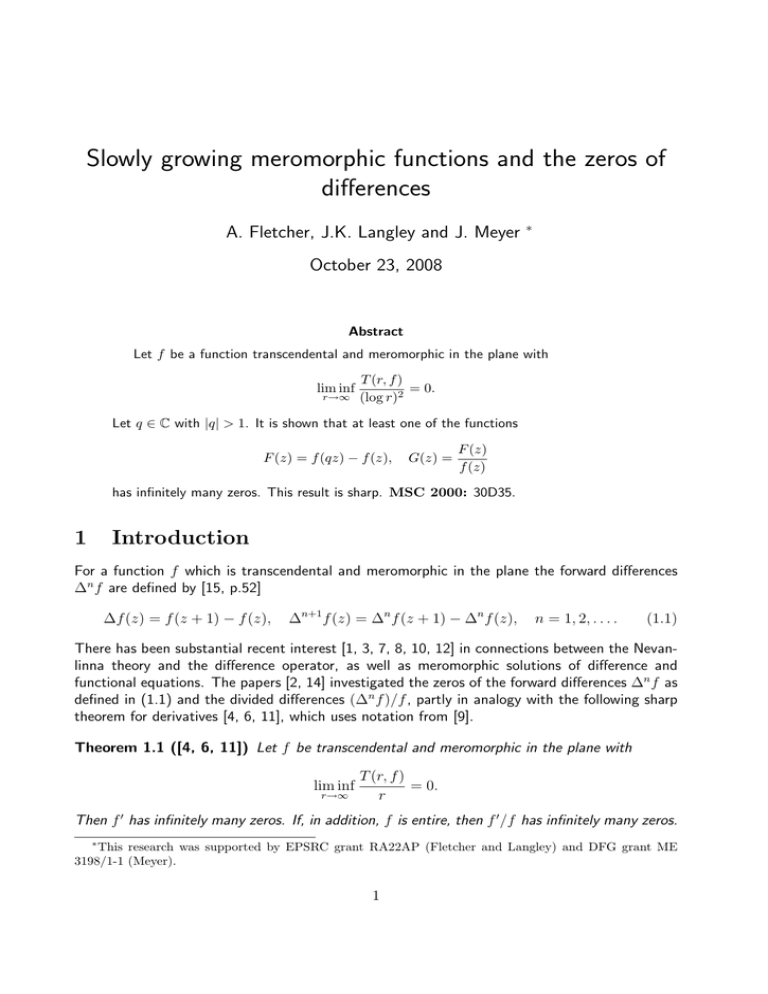
Slowly growing meromorphic functions and the zeros of
differences
A. Fletcher, J.K. Langley and J. Meyer
∗
October 23, 2008
Abstract
Let f be a function transcendental and meromorphic in the plane with
lim inf
r→∞
T (r, f )
= 0.
(log r)2
Let q ∈ C with |q| > 1. It is shown that at least one of the functions
F (z) = f (qz) − f (z),
G(z) =
F (z)
f (z)
has infinitely many zeros. This result is sharp. MSC 2000: 30D35.
1
Introduction
For a function f which is transcendental and meromorphic in the plane the forward differences
∆n f are defined by [15, p.52]
∆f (z) = f (z + 1) − f (z),
∆n+1 f (z) = ∆n f (z + 1) − ∆n f (z),
n = 1, 2, . . . .
(1.1)
There has been substantial recent interest [1, 3, 7, 8, 10, 12] in connections between the Nevanlinna theory and the difference operator, as well as meromorphic solutions of difference and
functional equations. The papers [2, 14] investigated the zeros of the forward differences ∆n f as
defined in (1.1) and the divided differences (∆n f )/f , partly in analogy with the following sharp
theorem for derivatives [4, 6, 11], which uses notation from [9].
Theorem 1.1 ([4, 6, 11]) Let f be transcendental and meromorphic in the plane with
lim inf
r→∞
T (r, f )
= 0.
r
Then f 0 has infinitely many zeros. If, in addition, f is entire, then f 0 /f has infinitely many zeros.
∗
This research was supported by EPSRC grant RA22AP (Fletcher and Langley) and DFG grant ME
3198/1-1 (Meyer).
1
In the light of Theorem 1.1 the natural conjecture was advanced in [2] that if f is a transcendental meromorphic function of order less than 1 then ∆f has infinitely many zeros, and if
f is entire then so has (∆f )/f . The following theorem from [14] extended results from [2].
Theorem 1.2 ([14]) Let n ∈ N. Let f be transcendental and meromorphic of order ρ < 1 in
the plane and assume that
∆n f (z)
Hn (z) =
f (z)
is transcendental.
(i) If Hn has lower order µ < α < 1/2, which holds in particular if ρ < 1/2, then
µ
δ(0, Hn ) ≤ 1 − cos πα or δ(∞, f ) ≤ .
α
(ii) If ρ = 1/2 then either Hn has infinitely many zeros or δ(∞, f ) < 1.
(iii) If f is entire and ρ < 1/2 + δ0 , then Hn has infinitely many zeros: here δ0 is a small positive
absolute constant.
We remark that if f is an entire function for which Hn fails to be transcendental for some
n ≥ 2 then f satisfies a homogeneous linear difference equation with rational coefficients and the
growth of such solutions was investigated in [12]. Moreover if f is a transcendental meromorphic
function of order less than 1 then H1 is always transcendental [2, 15]. The next result [2] applies
to meromorphic functions with no assumption on the deficiency of the poles.
Theorem 1.3 ([2]) Let f be a function transcendental and meromorphic in the plane of lower
order λ(f ) < 1. Let c ∈ C \ {0} be such that at most finitely many poles zj , zk of f satisfy
zj − zk = c. Then h(z) = f (z + c) − f (z) has infinitely many zeros.
Clearly all but countably many c ∈ C satisfy the hypotheses of Theorem 1.3, but an example
from [2] showed that Theorem 1.3 fails without the hypothesis on c, even for lower order 0. On
the other hand for transcendental meromorphic functions of sufficiently small order, either the
first difference or the first divided difference must have infinitely many zeros.
Theorem 1.4 ([14]) Let f be a transcendental meromorphic function in the plane, of order less
than 1/6. Then at least one of ∆f and (∆f )/f has infinitely many zeros.
The present paper was motivated by a question of Pat McCarthy at a recent conference in
honour of Brian Twomey: can any of the above results be proved with the forward difference
f (z + 1) − f (z) replaced by the so-called q-difference f (qz) − f (z)? For estimates for proximity
functions involving the q-difference, as well as applications to q-difference equations, we refer the
reader to [5]. We will prove the following theorem.
Theorem 1.5 Let q ∈ C with |q| > 1. Let f be a transcendental meromorphic function in the
plane with
T (r, f )
L(f ) = lim inf
= 0,
(1.2)
r→∞ (log r)2
and define F and G by
F (z)
F (z) = f (qz) − f (z), G(z) =
.
(1.3)
f (z)
Then at least one of F and G has infinitely many zeros.
2
The following simple example shows that the hypothesis (1.2) is sharp in Theorem 1.5. Let
q ∈ C with |q| > 1 and write
−1
−1
∞ ∞ Y
Y
z
z
f (z)
f (z) =
, f (qz) =
1 − n−1
=
.
1− n
q
q
1
−
qz
n=0
n=0
Hence G is a rational function and neither F nor G has infinitely many zeros, while L(f ) is
positive but finite. On the other hand it seems plausible that under the hypotheses of Theorem
1.5 both F and G must have infinitely many zeros.
2
Preliminaries for Theorem 1.5
The proof of Theorem 1.5 will rest mainly on the following lemma from [13].
Lemma 2.1 Let f be a transcendental meromorphic function in the plane and satisfy (1.2).
Then there exist sequences (rn ), (sn ), (an ) and (λn ) with
rn , sn ∈ (0, ∞),
lim rn = lim sn = ∞,
n→∞
n→∞
an 6= 0,
λn ∈ Z,
(2.1)
such that
where ε(z) = εn (z) = o(1) for rn s−1
n ≤ |z| ≤ rn sn .
f (z) = an z λn (1 + ε(z)),
(2.2)
Moreover it may be assumed that
0
ε (z) =
ε0n (z)
=o
1
|z|
for rn s−1
n ≤ |z| ≤ rn sn .
(2.3)
The estimate (2.2) is proved in [13, Lemma 12]. To deduce (2.3) it is only necessary to
√
replace sn by sn and apply Cauchy’s estimate for derivatives.
2
Lemma 2.2 Let q ∈ C with |q| > 1 and suppose that the sequences (rn ), (sn ), (an ) and (λn )
λn
satisfy (2.1) with λn 6= 0. If fn (z) is analytic on rn s−1
there,
n ≤ |z| ≤ rn sn with fn (z) ∼ an z
then there exists dn ∈ C \ {0} such that
fn (qz) − fn (z) ∼ dn z λn
for |z| = rn .
(2.4)
Proof. Let |z| = rn . Then
fn (qz) − fn (z) = an q λn z λn (1 + o(1)) − an z λn (1 + o(1)).
If λn > 0 this gives, since |q| > 1,
fn (qz) − fn (z) = an (q λn − 1)z λn + o |an |q λn |z|λn ∼ an (q λn − 1)z λn ,
while for λn < 0 we have
fn (qz) − fn (z) = an (q λn − 1)z λn + o |an ||z|λn ∼ an (q λn − 1)z λn .
2
3
Lemma 2.3 Let f be a transcendental meromorphic function in the plane satisfying (1.2), and
define G by (1.3). Then G is transcendental.
Proof. This is standard. Assume that G is a rational function. Then there exists a rational
function R such that f (qz) = R(z)f (z). Take s > 0, so large that R has no zeros or poles in
|z| ≥ s. By (1.2) the function f must have infinitely many zeros or poles, and so there exists z1
with |z1 | > s such that z1 is a zero or pole of f . But then so are qz1 , q 2 z1 , . . ., and so
lim inf
r→∞
N (r, f ) + N (r, 1/f )
> 0,
(log r)2
2
which contradicts (1.2).
Lemma 2.4 Let f be a transcendental meromorphic function in the plane satisfying (1.2), and
assume that f has either finitely many zeros in C or finitely many poles in C. Define G by (1.3).
Then G has infinitely many zeros in C.
Proof. Apply Lemma 2.1 to f . Since f has infinitely many zeros or poles in C by (1.2), it
follows from (2.2) and the argument principle that
λn = n(rn , 1/f ) − n(rn , f ) 6= 0.
Since |q| > 1 this leads using Lemma 2.2 to (2.4), where dn 6= 0. In particular we obtain
G(z) =
F (z)
dn
∼
f (z)
an
for |z| = rn ,
and so the argument principle gives n(rn , 1/G) = n(rn , G). But G must have infinitely many
zeros or poles, by (1.2) and Lemma 2.3, and Lemma 2.4 is proved.
2
3
Proof of Theorem 1.5
Let f , F and G be as in the statement of Theorem 1.5, and assume that F and G both have
finitely many zeros. Then by Lemma 2.4 we must have
lim n(r, 1/f ) = lim n(r, f ) = ∞.
r→∞
(3.1)
r→∞
Moreover, all but finitely many poles of f are poles of F of at least the same multiplicity, because
otherwise they would be zeros of G. This gives positive constants A0 , A1 such that
n(r, F ) ≥ n(r, f ) − A1
for r ≥ A0 .
(3.2)
Lemma 3.1 There exist sequences (Rn ), (Sn ), (bn ), (cn ), and (µn ) with
Rn , Sn ∈ (0, ∞),
lim Rn = lim Sn = ∞,
n→∞
n→∞
cn 6= 0,
µn ∈ Z \ {0},
(3.3)
such that
f (z) = bn + cn z µn (1 + δ(z)) where δ(z) = δn (z) = o(1) for Rn Sn−1 ≤ |z| ≤ Rn Sn . (3.4)
4
Proof. Apply Lemma 2.1 to f 0 . This gives sequences (rn ), (sn ), (an ) and (λn ) satisfying
(2.1) such that
f 0 (z) = an z λn (1 + ε(z)) where ε(z) = εn (z) = o(1) for rn s−1
n ≤ |z| ≤ rn sn .
(3.5)
Moreover it may be assumed that (2.3) also holds. Then λn 6= −1 in (3.5), since otherwise the
residue theorem gives
Z
0=
f 0 (z) dz ∼ 2πian ,
|z|=rn
a contradiction. Taking z as in (3.5) and integrating by parts from rn to z we obtain, for some
bn ∈ C,
f (z) = bn + cn z µn (1 + ε(z)) − R(z)
where, using (2.3),
µn = λn + 1 6= 0,
an
cn =
µn
Z
z
and R(z) =
cn tµn o t−1 dt.
rn
Here the path of integration may be taken to be an arc of the circle |t| = rn joining rn to
z ∗ = zrn /|z| followed by the radial segment from z ∗ to z.
If µn > 0 then we take z with rn ≤ |z| ≤ rn sn and we obtain |R(z)| = o (|cn ||z|µn ) as
required. Finally if µn < 0 then we take z with rn s−1
n ≤ |z| ≤ rn and this time
Z rn
µn
|R(z)| ≤ o (|cn |rn ) +
o |cn |sµn −1 ds = o (|cn ||z|µn ) .
|z|
2
This proves Lemma 3.1.
Lemma 3.2 With the same notation as in Lemma 3.1, assume without loss of generality that
limn→∞ bn = b ∈ C ∪ {∞}. Then the equation f (z) = b has finitely many solutions in C.
Proof. Set gn = f − bn . Then Lemma 2.2 and (3.4) give dn 6= 0 such that
F (z) = f (qz) − f (z) = gn (qz) − gn (z) ∼ dn z µn
for |z| = Rn .
Hence we obtain, using (3.4) again,
µn = n(Rn , 1/F ) − n(Rn , F )
= n(Rn , 1/gn ) − n(Rn , gn )
= n(Rn , 1/gn ) − n(Rn , f ).
Using (3.2) and the assumption that F has finitely many zeros this gives A2 > 0, independent
of n, such that
n(Rn , 1/gn ) ≤ A2 .
(3.6)
Now suppose that the equation f (z) = b has infinitely many solutions in C. Then there exists
T > 0 such that the equation f (z) = b has at least A2 + 1 distinct solutions in |z| < T , and
5
for large n so has the equation f (z) = bn , by Rouché’s theorem. But this implies that, for n
sufficiently large,
n(Rn , 1/gn ) ≥ n(T, 1/gn ) ≥ A2 + 1,
2
contradicting (3.6).
It follows from Lemma 3.2 and (3.1) that b ∈ C \ {0}. Applying Lemma 2.4 to h = f − b
then shows that the function
H(z) =
F (z)
h(qz) − h(z)
=
f (z) − b
h(z)
has infinitely many zeros. If these are poles of f then they are zeros of
G=
f −b
F
=H·
,
f
f
while if they are not poles of f then they are zeros of F . This completes the proof of Theorem
1.5.
2
Corollary 3.1 Let f be a transcendental meromorphic function in the plane satisfying (1.2), and
let a, b ∈ C with |a| 6= 0, 1. Then at least one of H(z) = f (az + b) − f (z) and H(z)/f (z) has
infinitely many zeros.
Proof. We begin by showing that in Theorem 1.5 the hypothesis |q| > 1 may be replaced
by 0 < |q| < 1. To see this, let f be as in the hypotheses of Theorem 1.5, let q be a complex
number with 0 < |q| < 1 and set p = 1/q and w = pz. If f (pz) − f (z) = f (w) − f (qw) has
infinitely many zeros then obviously so has f (qw) − f (w), so assume that this is not the case.
Then, by Theorem 1.5,
f (pz) − f (z)
f (z)
must have infinitely many zeros zk which are poles of f (z) of multiplicity mk but poles of
f (pz) − f (z) of multiplicity less than mk (possibly zero). Hence each zk must be a pole of f (pz)
of multiplicity mk and so a zero of
f (w) − f (qw)
f (pz) − f (z)
=
.
f (pz)
f (w)
This proves our assertion. To complete the proof of Corollary 3.1 choose d ∈ C with ad + b = d
and set z = t + d and f1 (t) = f (t + d). Then
H(z) = f (a(t + d) + b) − f (t + d) = f (at + d) − f (t + d) = f1 (at) − f1 (t)
and H(z)/f (z) = (f1 (at) − f1 (t))/f1 (t). Furthermore, (1.2) gives a sequence rn → ∞ with
n(4rn , f ) + n(4rn , 1/f ) + n(4rn , 1/(f − 1)) = o(log rn ).
6
Hence the second fundamental theorem gives sn ∈ [rn , 2rn ] such that
(1 − o(1))T (sn , f1 ) ≤
≤
≤
=
N (sn , f1 ) + N (sn , 1/f1 ) + N (sn , 1/(f1 − 1))
(n(2rn , f1 ) + n(2rn , 1/f1 ) + n(2rn , 1/(f1 − 1))) log 2rn + O(1)
(n(4rn , f ) + n(4rn , 1/f ) + n(4rn , 1/(f − 1))) log 2rn + O(1)
o(log sn )2 .
This shows that (1.2) holds with f replaced by f1 .
2
We close by remarking that if q is a root of unity then it is easy to choose f such that both
F (z) = f (qz) − f (z) and F (z)/f (z) have no zeros, while if |q| = 1 but q is not a root of unity
then the situation is unclear: in particular the proof of Lemma 2.2 breaks down because if |λn |
is large then q λn − 1 may be small.
References
[1] M. Ablowitz, R.G. Halburd and B. Herbst, On the extension of the Painlevé property to difference equations,
Nonlinearity 13 (2000), 889-905.
[2] W. Bergweiler and J.K. Langley, Zeros of differences of meromorphic functions, Math. Proc. Camb. Phil.
Soc. 142 (2007), 133-147.
[3] Y.M. Chiang and S.J. Feng, On the Nevanlinna characteristic of f (z + η) and difference equations in the
complex plane, Ramanujan J. 16 (2008), 105-129.
[4] J. Clunie, A. Eremenko and J. Rossi, On equilibrium points of logarithmic and Newtonian potentials, J.
London Math. Soc. (2) 47 (1993), 309-320.
[5] D.C. Barnett, R.G. Halburd, R.J. Korhonen and W. Morgan, Nevanlinna theory for the q-difference operator
and meromorphic solutions of q-difference equations. Proc. Roy. Soc. Edinburgh Sect. A 137 (2007), 457-474.
P∞ ak
,
[6] A. Eremenko, J.K. Langley and J. Rossi, On the zeros of meromorphic functions of the form k=1 z−z
k
J. d’Analyse Math. 62 (1994), 271-286.
[7] R.G. Halburd and R. Korhonen, Difference analogue of the lemma on the logarithmic derivative with applications to difference equations, J. Math. Anal. Appl. 314 (2006), 477-487.
[8] R.G. Halburd and R. Korhonen, Nevanlinna theory for the difference operator, Ann. Acad. Sci. Fenn. 31
(2006), 463-478.
[9] W.K. Hayman, Meromorphic functions, Oxford at the Clarendon Press, 1964.
[10] J. Heittokangas, R. Korhonen, I. Laine, J. Rieppo and K. Tohge, Complex difference equations of Malmquist
type, Comput. Methods Funct. Theory 1 (2001), 27-39.
[11] J.D. Hinchliffe, The Bergweiler-Eremenko theorem for finite lower order, Result. Math. 43 (2003), 121-128.
[12] K. Ishizaki and N. Yanagihara, Wiman-Valiron method for difference equations, Nagoya Math. J. 175 (2004),
75-102.
[13] J.K. Langley, On differential polynomials, fixpoints and critical values of meromorphic functions, Result.
Math. 35 (1999), 284-309.
[14] J.K. Langley, Value distribution of differences of meromorphic functions, to appear, Rocky Mountain J.
Math.
[15] J.M. Whittaker, Interpolatory function theory, Cambridge Tract No. 33, Cambridge University Press 1935.
School of Mathematical Sciences, University of Nottingham, NG7 2RD, UK.
alastair.fletcher@nottingham.ac.uk, jkl@maths.nott.ac.uk, janis meyer@gmx.de
7
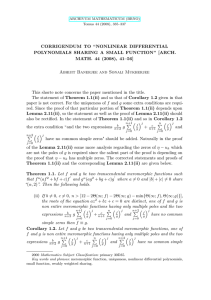
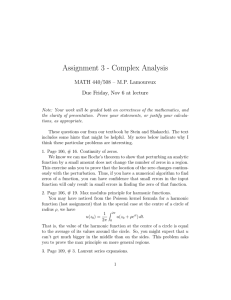
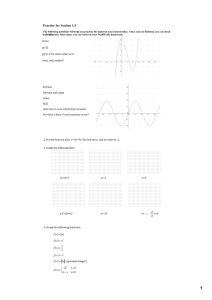
![Mathematics 414 2003–04 Exercises 5 [Due Monday February 16th, 2004.]](http://s2.studylib.net/store/data/010415766_1-b65af2bb66ab8e422354912dcedcb6a6-300x300.png)
